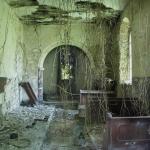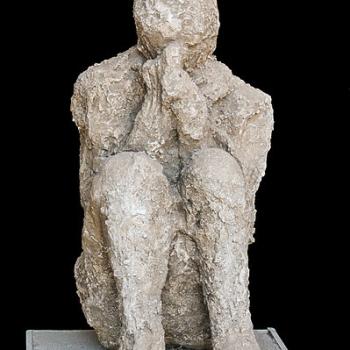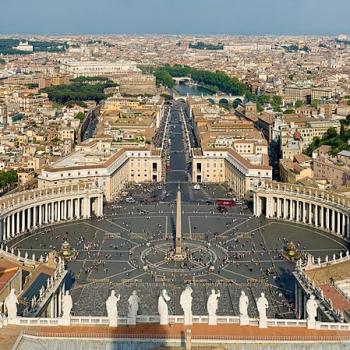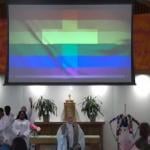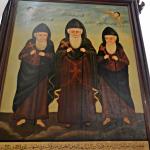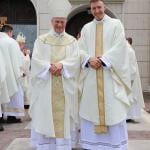A friend of mine found a disturbing detail buried in a lengthy report from bishop.accountability.org. The report, from 2007, specifically lists the Archdiocese of New York, the Archdiocese of Newark, the Diocese of Albany, the Congregation of Christian Brothers, and a number of bishops and clergy, including Cardinal Edward Egan and Archbishop John Myers.
The report states:
The plaintiff, FATHER ROBERT HOATSON, currently a NEWARK ARCHDIOCESAN priest and former CHRISTIAN BROTHER, claims retaliation and harassment due to the fact that Father Hoatson has been outspoken and critical of predatory priests/religious in the church and for the sexual abuse he suffered as a CHRISTIAN BROTHER, and also for assisting victims of clergy sexual abuse for the last five years.
There is much that is distressing and angering in this report. But here is the part that especially caught our eye:
The plaintiff is counseling a victim of a New York Archdiocesan priest whose sexual abuse continued for over ten years. One day, while the victim was being abused in the offices of the Propagation of the Faith in New York City, Bishop Fulton Sheen walked in on the abuse, called the victim a slut, told the priest to put his pants on, and did nothing to report the incident or comfort the victim. Bishop Sheen covered-up the crime. The priest abuser remains a pastor and had a prominent role in national television coverage of the funeral of Pope John Paul II. When the plaintiff wrote to the promoter of the cause of canonization of Bishop Sheen to inform him of Bishop Sheen’s actions, his letter was ignored and went unanswered. Bishop Sheen’s sainthood is steamrolling ahead despite his cover-up of child sexual abuse, while the plaintiff continues to be harassed, retaliated against, and fired.
Since that time, Fulton Sheen’s canonization process was indeed slowed down – but not due to complaints about complicity in cover-ups; rather because two different dioceses were squabbling over his body.
There was a time when I might have asked, “why would they ignore this” – but, that time is long past. Ignoring accusations against popular and powerful clerics appears to be the modus operandi among many Roman Catholic religious leaders, as the recent letter to Franciscan University from a survivor made clear.
In this case, we the laity need to speak out and demand transparency. Was this ever investigated? What happened to the letter? Has there been any follow-up?
As long as this accusation goes uninvestigated, as long as the hierarchy continues to ignore the letter from the plaintiff, the process of canonization of Fulton Sheen ought to be put on hold. The church leaders have already done enough damage, ignoring legacies of abuse for the sake of popularity of spiritual charisma.
Of course, if the case has been investigated and disproved, the church leaders could set our minds at ease and provide evidence that they did not ignore the letter, that they did follow up, and took the case seriously.
We’ll be waiting.

UPDATED: Since the posting of the report and of this piece, Simcha and Damien Fisher have published a piece on Ms. Fisher’s blog, containing more background information on the parties involved. The situation is more complex than it might initially appear. To sum up:
We cannot confirm independently that the accusation against Sheen is actually part of a real lawsuit. The information contained in the text which includes the allegations against Sheen appear to come solely from Hoatson’s account of what he says various sex abuse survivors told him. Hoatson was using these stories in his $5 million lawsuit.
In summary: There is no actual evidence that a crime occurred or that there is a victim, and there is no evidence that Hoatson or anyone else contacted the cause for Fulton Sheen and was ignored, as is asserted. The allegations of abuse and cover-up, and the allegations that the Cause didn’t respond, come entirely from a text that has yet to be verified, by a source and his attorney who both have significant credibility problems.
We reached out on Friday to the Archbishop Fulton Sheen Foundation and to Monsignor Soseman, who was delegated by Bishop Jenky to oversee the Cause, to ask if they had heard of these allegations and whether they were investigated. We have not yet heard back. Since the text making allegations have been circulating, we thought it was important to follow up quickly with more information; but we will update this story if and when more information becomes available.
It is entirely possible, of course, that the accusation is false, especially given that there is, as yet, no evidence that a suit was filed. However, I can not reiterate strongly enough that, given the seriousness and extensiveness of the abuse crisis, it would be irresponsible on the part of those overseeing the Cause to move forward without addressing this. This is not simply a case of whether or not we can remember a Catholic personality fondly – as of course many hope to do. This is a canonization procedure, which must proceed with the utmost seriousness, and should never be rushed.
In fact, this is the tradition of the Church. For centuries, the process of beatification or canonization necessitated the intimate participation of the Promotor of the Faith, popularly known as the “devils advocate”, whose official duty was to bring up any possible objection to the cause. As the Catholic Encyclopedia states:
His duty requires him to prepare in writing all possible arguments, even at times seemingly slight, against the raising of any one to the honours of the altar. The interest and honour of the Church are concerned in preventing any one from receiving those honours whose death is not juridically provedto have been “precious in the sight of God” (seeBEATIFICATION and CANONIZATION). Prospero Lamertini, afterwards Pope Benedict XIV(1740-58), was the Promoter of the Faith for twenty years, and had every opportunity to study the workings of the Church in this most important function; he was, therefore, peculiarly qualified to compose his monumental work “On the Beatification and Canonization of Saints,” which contains the complete vindication of the rights of the Church in this matter, and sets forth historically its extreme care of the use of this right. No important act in the process of beatification or canonization is valid unless performed in the presence of the Promoter of the Faith formally recognized. His duty is to protest against the omission of the forms laid down, and to insist upon the consideration of any objection. The first formal mention of such an officer is found in the canonization of St. Lawrence Justinian under Leo X (1513-21). Urban VIII, in 1631, made his presence necessary, at least by deputy, for the validity of any act connected with the process of beatification or canonization.
Even if this accusation seems to be tenuous or motivated by spite, the proper forms of canonization require that it be looked into. And we have a duty to survivors to demand that our religious leaders proceed with prudence, not letting reputation or popularity interfere with the obligation to seek truth and justice without partiality.
image credit: https://commons.wikimedia.org/wiki/File:Fulton_J._Sheen_NYWTS.jpg



